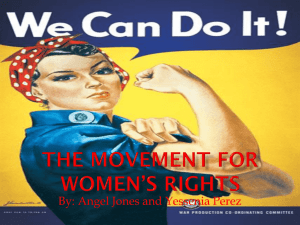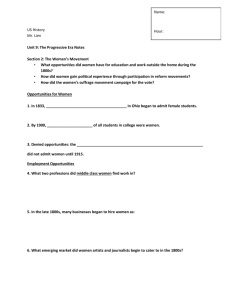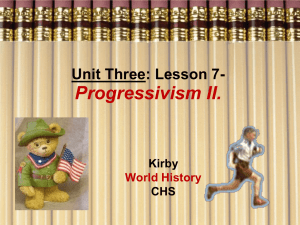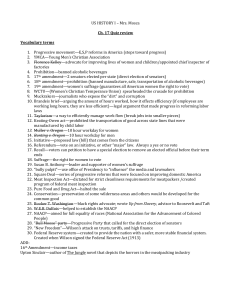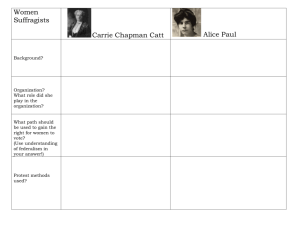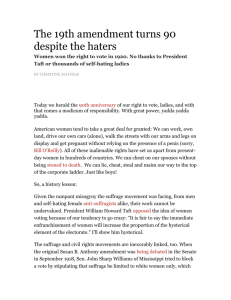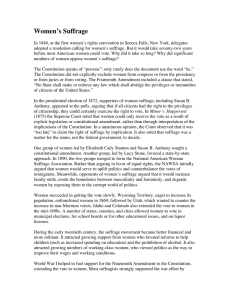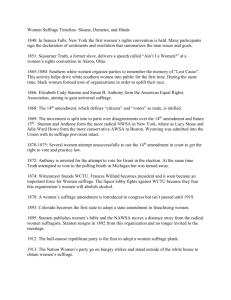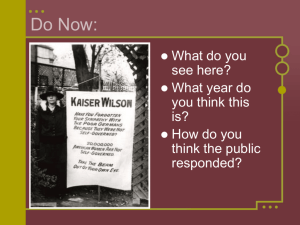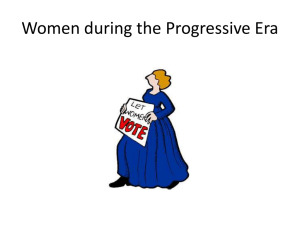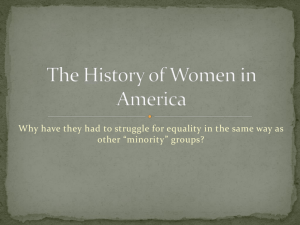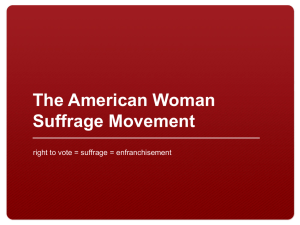Women's Suffrage
advertisement
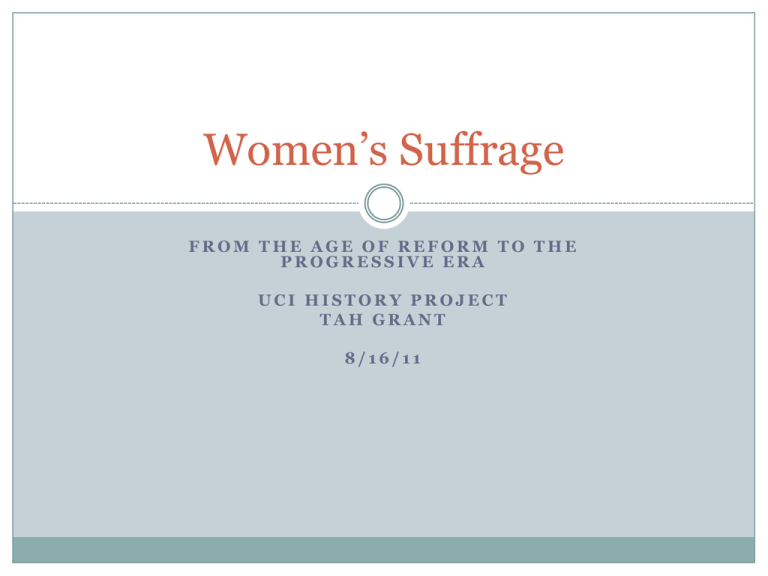
Women’s Suffrage FROM THE AGE OF REFORM TO THE PROGRESSIVE ERA UCI HISTORY PROJECT TAH GRANT 8/16/11 The Beginning THE AGE OF REFORM THROUGH RECONSTRUCTION The Second Great Awakening was a religious revival movement of the 1830s and 1840s. The Second Great Awakening Women were active participants in the movement and were ultimately inspired to move beyond the home into community reform activities and projects, especiall ones that involved children, the infirm, education, or the family. The Second Great Awakening Note the signature of Frederick Douglass. Many supporters of abolition were also supporters of women’s rights. The Seneca Falls Convention, 1848 Elizabeth Cady Stanton in Bloomers Lucretia Mott Elizabeth Cady Stanton Sojourner Truth The 14th Amendment Section 2. Representatives shall be apportioned among the several States according to their respective numbers, counting the whole number of persons in each State, excluding Indians not taxed. But when the right to vote at any election for the choice of electors for President and Vice President of the United States, Representatives in Congress, the Executive and Judicial officers of a State, or the members of the Legislature thereof, is denied to any of the male inhabitants of such State, being twenty-one years of age, and citizens of the United States, or in any way abridged, except for participation in rebellion, or other crime, the basis of representation therein shall be reduced in the proportion which the number of such male citizens shall bear to the whole number of male citizens twenty-one years of age in such State. The 15th Amendment Section 1. The right of citizens of the United States to vote shall not be denied or abridged by the United States or by any State on account of race, color, or previous condition of servitude. Section 2. The Congress shall have power to enforce this article by appropriate legislation. The Movement Gains Force THE PROGRESSIVE ERA 1890 TO 1920 Key Milestones 1890: NWSA and AWSA merge to form the National American Woman Suffrage Association. 1907: Spectacular tactics—parades, street speakers, pickets— are introduced to the US campaign. 1912—The Progressive Party includes a woman suffrage plank in its platform. 1912—The National Women’s Party forms and embraces more radical tactics, such as daily pickets of the White House and public burning of Wilson’s speech. 1919—The House and Senate approve the 19th Amendment. 1920—3/4 of the states ratify the 19th Amendment and women gain the unconditional right to vote (unless they are Chinese or Native American…) Susan B. Anthony Carrie Chapman Catt The Western United States was ahead of the South and the East in terms of granting women’s suffrage. Suffrage in California Failed initiative in 1896 In 1910, Progressives took over the Republican Party in CA and this gave women new hope. They campaigned up and down the state for 8 months, focusing on more supportive rural areas. Supporters of suffrage used modern advertising methods: slogans, giant posters, billboards, buttons, leaflets, pennants, banners, electric signs, and lantern slides, even grocery bags recommending suffrage “For Home and Family.” They won by 3, 587 out of 246,487 cast—mainly due to rural support. Key Slogans “THE DIRTY POOL OF POLITICS—Can we clean it? Give us a chance!” “Justice for California Women—Give your girl an equal chance with your boy.” “EQUAL PAY FOR EQUAL WORK—Regardless of Sex.” …and many signs comparing California to other Western states where women could vote to foster a competitive spirit. Massachusetts Campaign for Suffrage Drawing on Revolutionary Rhetoric in the East Historigraphy ELLEN DUBOIS—UCLA GAYLE GULLETT—UNIVERSITY OF ARIZONA Opposition ECONOMIC, POLITICAL, REGIONAL, MORAL Anti-Suffrage Interests 1. Businesses 2. Politicians 3. Regional Politics 4. Defenders of the Home Looking Backward Probably the most effective argument against women’s right to vote was that it would damage the family and therefore ultimately be harmful to women themselves. Laura Foster, Life Magazine, 1912 Alice Duer Miller—Writer, journalist, suffrage activist (1915) Why We Don't Want Men to Vote Because man's place is in the army. Because no really manly man wants to settle any question otherwise than by fighting about it. Because if men should adopt peaceable methods women will no longer look up to them. Because men will lose their charm if they step out of their natural sphere and interest themselves in other matters than feats of arms, uniforms, and drums. Because men are too emotional to vote. Their conduct at baseball games and political conventions shows this, while their innate tendency to appeal to force renders them unfit for government.
